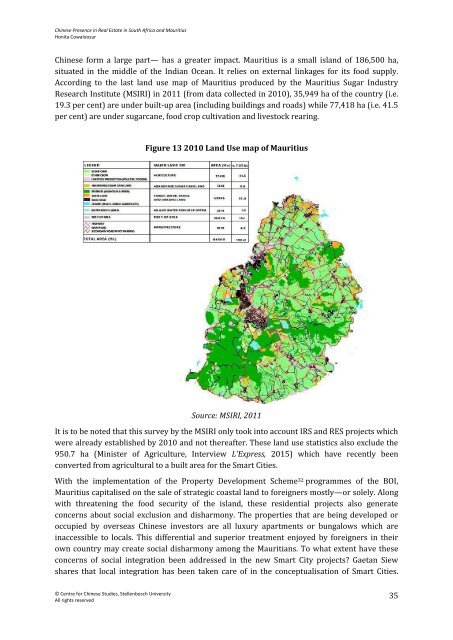and Mauritius
CCS_Research-Report_Chinese_Presence_South-Africa_Mauritius_Honita_Cowaloosur_2016
CCS_Research-Report_Chinese_Presence_South-Africa_Mauritius_Honita_Cowaloosur_2016
You also want an ePaper? Increase the reach of your titles
YUMPU automatically turns print PDFs into web optimized ePapers that Google loves.
Chinese Presence in Real Estate in South Africa <strong>and</strong> <strong>Mauritius</strong><br />
Honita Cowaloosur<br />
Chinese form a large part— has a greater impact. <strong>Mauritius</strong> is a small isl<strong>and</strong> of 186,500 ha,<br />
situated in the middle of the Indian Ocean. It relies on external linkages for its food supply.<br />
According to the last l<strong>and</strong> use map of <strong>Mauritius</strong> produced by the <strong>Mauritius</strong> Sugar Industry<br />
Research Institute (MSIRI) in 2011 (from data collected in 2010), 35,949 ha of the country (i.e.<br />
19.3 per cent) are under built-up area (including buildings <strong>and</strong> roads) while 77,418 ha (i.e. 41.5<br />
per cent) are under sugarcane, food crop cultivation <strong>and</strong> livestock rearing.<br />
Figure 13 2010 L<strong>and</strong> Use map of <strong>Mauritius</strong><br />
Source: MSIRI, 2011<br />
It is to be noted that this survey by the MSIRI only took into account IRS <strong>and</strong> RES projects which<br />
were already established by 2010 <strong>and</strong> not thereafter. These l<strong>and</strong> use statistics also exclude the<br />
950.7 ha (Minister of Agriculture, Interview L’Express, 2015) which have recently been<br />
converted from agricultural to a built area for the Smart Cities.<br />
With the implementation of the Property Development Scheme 32 programmes of the BOI,<br />
<strong>Mauritius</strong> capitalised on the sale of strategic coastal l<strong>and</strong> to foreigners mostly—or solely. Along<br />
with threatening the food security of the isl<strong>and</strong>, these residential projects also generate<br />
concerns about social exclusion <strong>and</strong> disharmony. The properties that are being developed or<br />
occupied by overseas Chinese investors are all luxury apartments or bungalows which are<br />
inaccessible to locals. This differential <strong>and</strong> superior treatment enjoyed by foreigners in their<br />
own country may create social disharmony among the Mauritians. To what extent have these<br />
concerns of social integration been addressed in the new Smart City projects? Gaetan Siew<br />
shares that local integration has been taken care of in the conceptualisation of Smart Cities.<br />
© Centre for Chinese Studies, Stellenbosch University<br />
All rights reserved<br />
35


